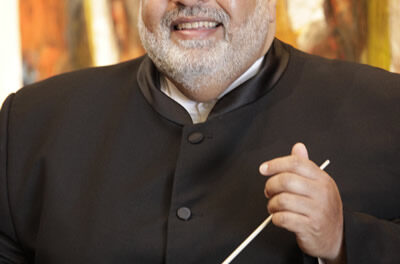The Chapel Hill Philharmonia performed its fall concert in Hill Hall on the campus of UNC on Sunday evening, November 20, 2005. Founded in 1983, the group is a community symphony orchestra performing classical music in the Triangle area for the love of performing. Their music director is Donald L. Oehler, a faculty member at UNC. The 2005-6 season is under the direction of guest conductor Edward Szabo, recently retired Professor of Music from Eastern Michigan University. The musicians are drawn together by a desire to perform orchestral works both classical and modern and membership is open to community members and college students without audition. The Philharmonia is supported by member and community contributions.
The program opened with a performance of core Beethoven – the Egmont Overture, Op. 84, composed as part of a set of incidental music for Goethe’s tragedy. Beethoven strongly identified with the play’s themes of the evil of tyranny and the heroism of those who fight for liberty, and he wrote some powerfully dramatic numbers. The orchestra seemed quite familiar with the music and played with gusto galore. It reminded me of my high school band experience and my first introduction to the piece. My older mentors (who seemed like pros at the time) advised me, “If you can’t play good, play loud” – although in this case it may have been the lively acoustics of Hill Hall, half full, that prompted this impression. Though a tiny bit ragged in places, it was none-the-less a pleasure to hear Beethoven played with such enthusiasm.
Edvard Grieg’s Suite in the Old Style, “from Holberg’s Time,” Op. 40 (often referred to as The Holberg Suite), is a set of baroque dances. The music varies from robust rhythms to measured elegance to lyrical and austere beauty. The final movement, a rigaudon, featured fine performances by the principals of the violin and viola sections, Mark Furth and Kitty Stalberg. Other solo and small ensemble portions of the suite displayed the fact that there is some fine talent in the Philharmonia.
The orchestra took advantage of the presence of Petra Berényi, a master of the cimbalom, a not-so-often heard instrument, to perform the Intermezzo from Zoltán Kodály’s Háry János Suite, Op. 15. The cimbalom is a member of the hammered dulcimer family, played with mallets wrapped in cotton, wool or leather. A concert version of the instrument, with 125 strings of piano wire and a range of up to five octaves, was developed by József Schunda in Budapest around 1875. Kodály’s colorful music, as always, reflects his knowledge and love of the folk music of his native Hungary and beyond. He and his friend Béla Bartók collected, transcribed, and catalogued over 100,000 folk songs over the span of their lifetime. Berényi’s vigorous playing added an almost ethereal primitive rush to this exciting music.
The cimbalom also played a prominent role in the ensemble performing Igor Stravinsky’s Ragtime for Eleven Instruments (1918). During his Paris years, Stravinsky became entranced with the cimbalom after hearing it played by Aladár Rácz, a Hungarian gypsy. He also was fascinated by ragtime, introduced through sheet music brought to him from America by conductor Ernest Ansermet. Well, Stravinsky was Stravinsky, and no musical sound touched him that did not inspire him to create his own. It was a pure, syncopated, frolicking joy to hear this music. The music makers who participated in the performance were groovin’ to be sure, and their delight – and the audience’s – was just about equal.
The concert ended with Howard Hanson’s Symphony No. 2 (“Romantic”), one of his most successful works. Composed 1928-30, it exhibits none of the avant-garde, atonal, or rhythmic experimentation that was the rage of the time. It rather reflects the romanticism of Grieg and Sibelius, two of his major influences. It is characterized by lush harmonies and lyrical melodies, and I almost expected to see Jean Harlow and William Powell emerge from a side entrance. Still, it was a pleasurable and impressive performance.
How fortunate we are to live in a community that attracts professionals in a variety of careers who bring with them such talent, training, and love for music and offer it for free to their friends and neighbors! Thank you, ladies and gentlemen of the Chapel Hill Philharmonia – doctors, professors, teachers, housewives, students, engineers… – thank you all!













